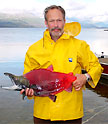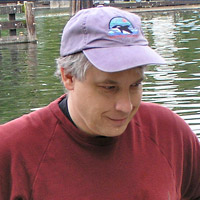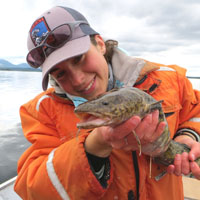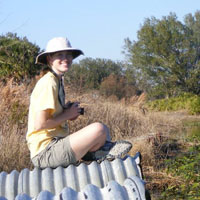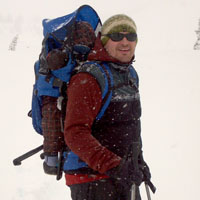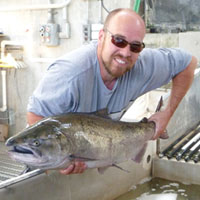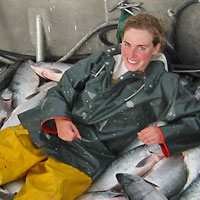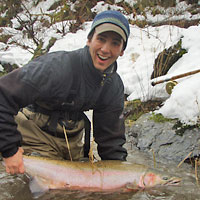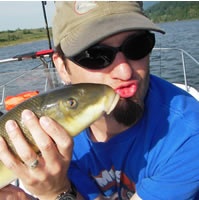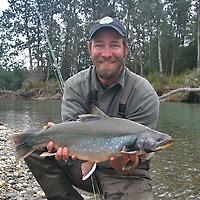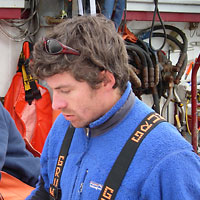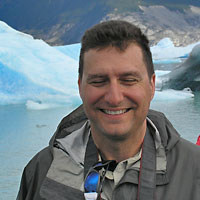Students
Current Graduate Students |
|
Curry Cunningham (MS) |
Curry is a former Bristol Bay commercial fisherman and received his B.S. in Animal Biology from the University of British Columbia, Vancouver. His current graduate research at the University of Washington is partitioned into four categories. First, the evolutionary ecology of sockeye salmon in Bristol Bay Alaska, specifically evaluating interactions between selective pressure from predation, harvest, competition, and sexual processes. Second, statistical approaches to allocating catches of Bristol Bay sockeye and estimating interception rates among spatially segregated fishing districts with the purpose of reconstructing annual return sizes. Third, improving established techniques for preseason and real-time forecasting of sockeye salmon returns, by incorporating biological and environmental data. Fourth, modeling the population dynamics of threatened and endangered Chinook salmon populations in California’s Sacramento River watershed, to determine the critical environmental drivers of survival from anthropogenic and natural sources, and evaluate the effect of competition with hatchery reared stocks. |
|
Fred Goetz (PhD) |
Fred received his M.S. from Oregon State University where he studied the ecology of bull trout and since then he has worked for the U.S. Army Corps of Engineers as a fish biologist studying the movements of salmon and trout in Puget Sound. In his professional work, Fred has evaluated fish passage and habitat conditions at several Corps dams and navigation projects including in the Green River, White/Puyallup Rivers, the Ballard Locks, and the Snohomish, Stillaguamish, Skagit, and Nooksack Rivers. At the Locks Fred helped design and evaluate a fish passage system for protection of migrating salmon smolts. In development of the system, he tested and evaluated three behavioral guidance techniques (low-frequency sound, strobe lights, and slowing the fill rate of the lock) to keep smolts from becoming entrained in the filling system for the locks. Strobe lights and slowing the fill rate were found to be effective in reducing entrainment and these techniques are now part of the smolt passage system. As part of this work at the Locks, Fred helped develop a long-term monitoring plan for the Lake Washington system by including PIT-tag monitors in flumes that are designed to pass smolts from freshwater to Shilshole Bay. Juvenile Chinook and coho salmon have been tagged in various Lake Washington tributaries and monitored with the readers since 2000. As part of an assessment of dredging projects in Puget Sound rivers, Fred has been monitoring bull trout behavior and habitat use in estuary and nearshore areas in northeast Puget Sound since 2002. This work is the first research to study the anadromous life history type of bull trout. This research is being used in recovery planning for ESA-listed Puget Sound bull trout. His dissertation project is a multi-species investigation of salmonid movements using ultrasonic telemetry. Working in cooperation with a large number of investigators from various agencies (e.g., NOAA-Fisheries, Washington Department of Fish and Wildlife, Seattle City Light, Nisqually Tribal Fisheries Office) he has been tagging steelhead, anadromous cutthroat trout and bull trout, and coho and Chinook salmon. These species range from those thought to invariably migrate to the Pacific ocean for feeding (steelhead), to species that may reside in Puget Sound or migrate to the coast (coho and Chinook salmon) and those thought to invariably remain within Puget Sound, near their natal rivers (cutthroat and bull trout). The telemetry study should provide insights into the basic biology of these species and also facilitate conservation efforts. Selected Publications:
|
Daniel Hernandez |
Daniel is a second year graduate student at the School of Aquatic and Fishery Sciences at the University of Washington. He completed a Bachelors of Science degree in Environmental Science from Humboldt State University. He was awarded a National Science Foundation Graduate Research Fellowship in 2011. Daniel’s research interests and experience span a wide range of topics from chemical oceanography and marine ecosystems dynamics to the behaviors and life history strategies of Chinook salmon throughout the Pacific Northwest. His current investigation is exploring the role of Chinook salmon in the ecology of infectious hematopoietic necrosis virus (IHNV) in the Columbia River Basin. |
Rachel Hovel (PhD) |
Rachel is broadly interested in the processes of community ecology in freshwater systems and the ways in which organisms cope with habitats that vary in time and space. Her dissertation research focuses on fish communities in large coastal lake systems, and explores how diversity among and within species affect species interactions in variable environments. Current projects include work in the Wood River lakes of Bristol Bay, Alaska, where shifts in community composition and the expression of life history events are explained with climate change signals over a five decade time series. Other research in Lake Washington seeks to answer questions of how phenological diversity helps buffer against seasonal variability in resources, and how species interactions can shape foraging behavior in a pelagic food web. For more information about Rachel’s research and teaching, see her website. |
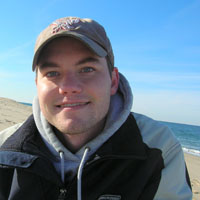
Joseph M. Smith |
Joe completed his Ph.D. from the University of Massachusetts Amherst in 2012. One of his principal research interests is examining the causes and consequences of fish movement within ecosystems. He has used telemetry to study the movement of alewife, striped bass, crayfish, blue catfish, and Pacific salmon in Massachusetts, Kansas and Washington State. Other research interests include determining how natural (e.g., beaver dams) and human factors (e.g., human dams) influence fish populations and assemblages. His current post-doctoral work is examining the seasonal and diel variation in depth distribution of sub-adult coho and Chinook salmon in Puget Sound. Recent publications:
|
Emily Thornton (MS) |
Emily received her BS in Biology and Environmental Science from Allegheny College in 2010 and spent two years working seasonal research and environmental education positions before starting at SAFS. She is generally interested in community ecology and behavior of diadromous fish. For her MS thesis, Emily is studying the recolonization of salmonids in the Elwha River, WA post-dam removal. Specifically, she is interested in investigating how the presence of non-native, resident brook trout (Salvelinus fontinalis) affects recolonization by coho salmon (Oncorhynchus kisutch). |
|
Mike was born in Seattle and during a childhood spent salmon fishing from Puget Sound beaches he developed a profound interest in salmon and their peculiar life history. While obtaining his bachelor of arts in environmental studies and anthropology at Bowdoin College in Brunswick, Maine, it was the study of local, depleted Atlantic salmon runs and working in the Bristol Bay sockeye salmon fishery during the summer that helped him to develop an appreciation of the interconnectedness of human and ecological systems. After working in environmental consulting for two years Mike decided to continue his study of marine social-ecological systems at the University of Washington’s School of Marine and Environmental Affairs where he received his M.M.A in 2013. As a doctoral student at the University of Washington’s School of Aquatic and Fishery Sciences Mike continues to allow his passion for understanding, protecting and catching salmon to guide his studies. His interdisciplinary research explores the relationships between climate change, marine and aquatic ecosystems, salmon and the people who depend on them. |
Peter Westley |
Peter completed his Ph.D. from Memorial University of Newfoundland in 2012 where he used the introduction of brown trout as a natural experiment to examine broad ecological and evolutionary questions. Generally speaking, Peter is interested in understanding how organisms adapt, both through genetic adaptation and phenotypic plasticity, to novel environments. His post-doctoral work aims to better understand the behavioral patterns and processes of colonization by utilizing PIT tag and coded wire tag data from Columbia River salmon and steelhead. Recent publications:
|
Jon Whittouck (MS) |
Jon's reasearch explores the movement patterns of coastal cutthroat trout in Puget Sound. He is interested in interactions with other salmonid species and environmental factors as driver of their movement. Jon has been the Aquatic Lab Manager for nine years and is currently working part time while he pursues an M.S. degree in the Quinn Lab. |
Recently Graduated Students |
|
Morgan Bond (PhD, 2013) |
Morgan is interested in the life history diversity of fishes in the Chignik Lakes watershed on the Alaska Peninsula. His particular focus is the population structure and habitat use of Dolly Varden (Salvelinus malma) within the Chignik Lakes drainage, as well as the consequences for salmonids rearing in the large and unique Chignik lagoon. Prior to entering the University of Washington, he received his M.S. from the University of California at Santa Cruz and worked at the National Marine Fisheries Service laboratory there on the ecology of coho salmon and steelhead trout at the southern end of their range in North America. Selected Publications:
|
Dan Hasselman (Post-doc, 2012) |
Dan has broad interests in evolutionary biology, molecular ecology and conservation. His research explores the evolution of wild anadromous fish populations over contemporary time scales, and aims to bridge the gap between academia and application by employing molecular and non-molecular tools to provide linkages between evolutionary biology and practical conservation. See his website for details of specific research interests. Selected Publications
|
Neala Kendall (MS 2007, PhD 2011) |
Neala Kendall received her BA in biology from Kenyon College in Ohio. After a three-year stint doing environmental consulting in northern California she moved to Seattle to begin her graduate work at SAFS. For her master's thesis, Neala quantified fishery selection by a gillnet fishery on age and size at maturity of sockeye salmon in Bristol Bay, Alaska. She examined selection from 1946-2007 at two scales, the Nushagak District (Kendall et al. 2009), and individual spawning populations within the Wood River system that differ in age and size at maturity (Kendall and Quinn 2009). Neala extended this project for her PhD, for which she investigated potential life history evolution resulting from this fishery selection. Neala first worked on a project to analyze long term data on age and size at smolt transformation and maturation of wild and common garden-reared Columbia River sockeye salmon populations to better understand how genetic and environmental effects impact age and size at maturation (Kendall et al. 2010 ESR). She found that genetic effects play a role in influencing these traits, suggesting that fishery selection has the potential to result in evolutionary changes in Pacific salmon. In other PhD chapters Neala has used vulnerability profiles and selection differentials to quantify commercial fishery selection on Bristol Bay, Alaska sockeye salmon across fishing districts where different types of fishing gear is employed (Kendall and Quinn in prep) and both commercial and recreational fishery selection on one population of Bristol Bay Chinook salmon (Kendall and Quinn 2011 TAFS). Finally, in the remaining chapters of her dissertation Neala tested the hypothesis that trends in age and size at maturation of Bristol Bay sockeye salmon are driven by environmental effects in conjunction with selective fishing and teasing apart phenotypic plasticity and genetic changes using probabilistic maturation reaction norms and quantitative genetics models. Neala enjoys the balance of fieldwork and quantitative analyses employed in her research, and she has also appreciated her recent classes in science communication. After graduating, Neala became a Post-Doctoral Research Assistant at the Northwest Fisheries Science Center. Selected Publications:
|
Jessica Rohde (MS, 2013) |
For her M.S. research, Jessica examined the phenomenon of partial migration in Puget Sound Coho Salmon. The project approached the problem from both the population and individual level using complementary data: 1) data from a network of acoustic telemetry receivers within the Puget Sound to allow investigation of the small-scale vertical and horizontal movements of individuals, and 2) analysis of coded wire tag records of Puget Sound hatchery and wild coho to reveal internal and external factors that make coho more likely to remain resident in Puget Sound. Jessica is passionate about science communication. After graduating, Jessica went on to help her colleagues at SAFS improve their web presence, teach graduate students to better communicate their research at the Engage Seminar, and build science communication tools for Conservation Magazine. Find out more about her research and communication activities on her website.
|
Pamela Woods (dual PhD degree, UW and University of Iceland, 2011) |
Pamela earned a dual doctoral degree between the University of Washington and the University of Iceland. This is the first such dual degree that the University of Washington has allowed with an external university. As part of a European Research Training Network, FishACE, she began her dissertation in January 2008 by studying evolutionary patterns of divergence in Arctic char populations, and how these relate to local ecological conditions of lakes across Iceland. Her supervisors are Skúli Skúlason (Hólar University College, Iceland), Siggi Snorrason (University of Iceland), and Thomas Quinn (University of Washington). She continued with a comparison of Icelandic freshwater food webs and those at field sites in Alaska, another high-latitude region that is geologically older and more biologically diverse. These projects will aid natural resource management by yielding an understanding for how environmental issues, such as global climate change or exploitation, may affect the ecology of freshwater systems. After graduating, Pamela became a Post-Doctoral Research Assistant in the Marice lab with Dr. Guðrún Marteinsdóttir (Iceland).
|
Joseph Anderson (MS 2007, PhD 2011) |
Joe Anderson's research in the Quinn lab investigated the process of salmon colonization on a local Washington river where the construction of fish passage facilities have permitted coho and Chinook salmon to access habitat they had been denied for over 100 years. His M.S. thesis work described the movements of adult coho salmon in the new habitat (Anderson and Quinn 2007), as well as the distribution of juvenile coho in relation to adult spawning sites (Anderson et al. 2008). His dissertation research employed molecular genetics to evaluate the individual and population-level reproductive success of both coho and Chinook salmon during colonization. After graduating, Joe became a Post-Doctoral Research Assistant at the Northwest Fisheries Science Center. Selected Publications:
|
Thomas Buehrens (MS, 2011) |
Thomas' research in the Quinn lab investigated the ecology of rainbow and cutthroat trout in the Cedar River, Washington. Fish populations in this river were segregated in 1901, when a diversion dam was built, preventing migratory fish from accessing the upper watershed. Trout populations living in the river upstream of the dam were forced to adopt resident life histories and were isolated from below-dam populations of trout and anadromous Pacific salmon. In 2003, modification of the dam restored passage for migrating fish, and allowed coho and Chinook salmon to spawn above the dam. Thomas investigated the effects of restored habitat connectivity and colonizing salmon on coastal cutthroat and rainbow trout. His methodology employed Passive Integrated Transponder (PIT) tags to study the growth, movement, and survival of trout, molecular genetics to distinguish between trout species and hybrids, and stable isotope chemistry to relate growth and movement of individual trout with potential forage resources. After Graduating, Thomas became a Research Fishery Biologist with Wild Fish Conservancy. |
Todd Seamons (PhD, 2005; Post-Doc, 2011) |
Todd's research with the Quinn lab investigated the evolution of fitness traits of fishes in natural and human-manipulated environments, utilizing molecular and quantitative genetic methods to 1) to determine evolutionary processes in fish populations and 2) investigate the impacts of management and conservation on these processes. His work specifically focues on salmonids, which have diverse life histories, are of significant regional management and conservation interest and are cultured on an extensive scale. He also used genetic tools to investigate impacts of hatchery steelhead on wild populations. After completing his post-doc, Todd went to work with the Washington Department of Fish and Wildlife. Selected Publications:
|
Troy Jaecks (MS, 2010) |
Troy's thesis was on population dynamics and trophic ecology of Dolly Varden in the Iliamna River, Alaska [PDF]. After graduating, Troy continued his work with the Alaska Department of Fish and Game. |
Joshua Chamberlin (MS, 2009) |
Josh's thesis was on early marine migratory patterns and the factors that promote resident type behavior of Chinook salmon, Oncorhynchus tshawytscha, in Puget Sound, Washington [PDF]. After graduating, Josh went to work at the Northwest Fisheries Science Center. |
George Pess (PhD, 2009) |
George's dissertation was on patterns and processes of salmon colonization [PDF]. After graduating, George became a Supervisory Research Fishery Biologist in the Watershed Program at the Northwest Fisheries Science Center. |
Graduate Students SupervisedMaster of Science degrees
Doctor of Philosophy degrees
|
|
